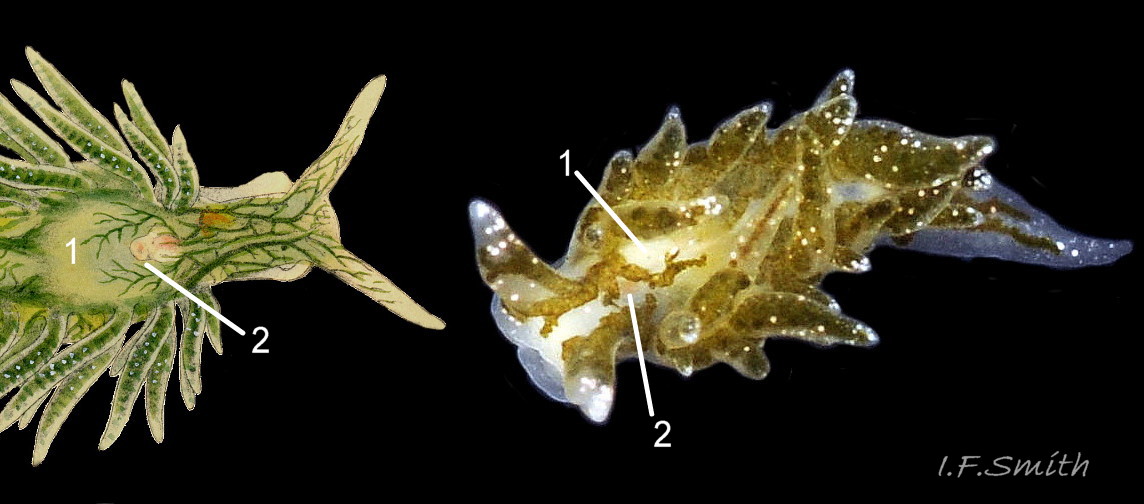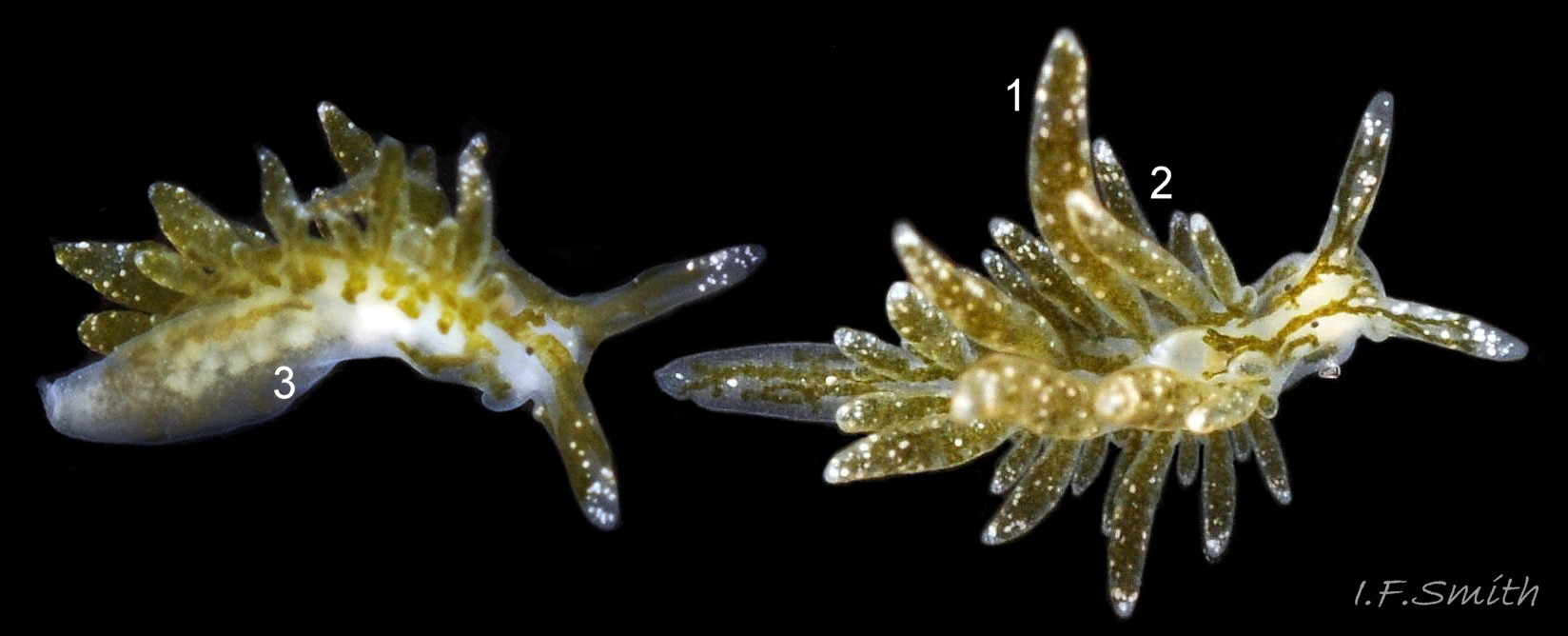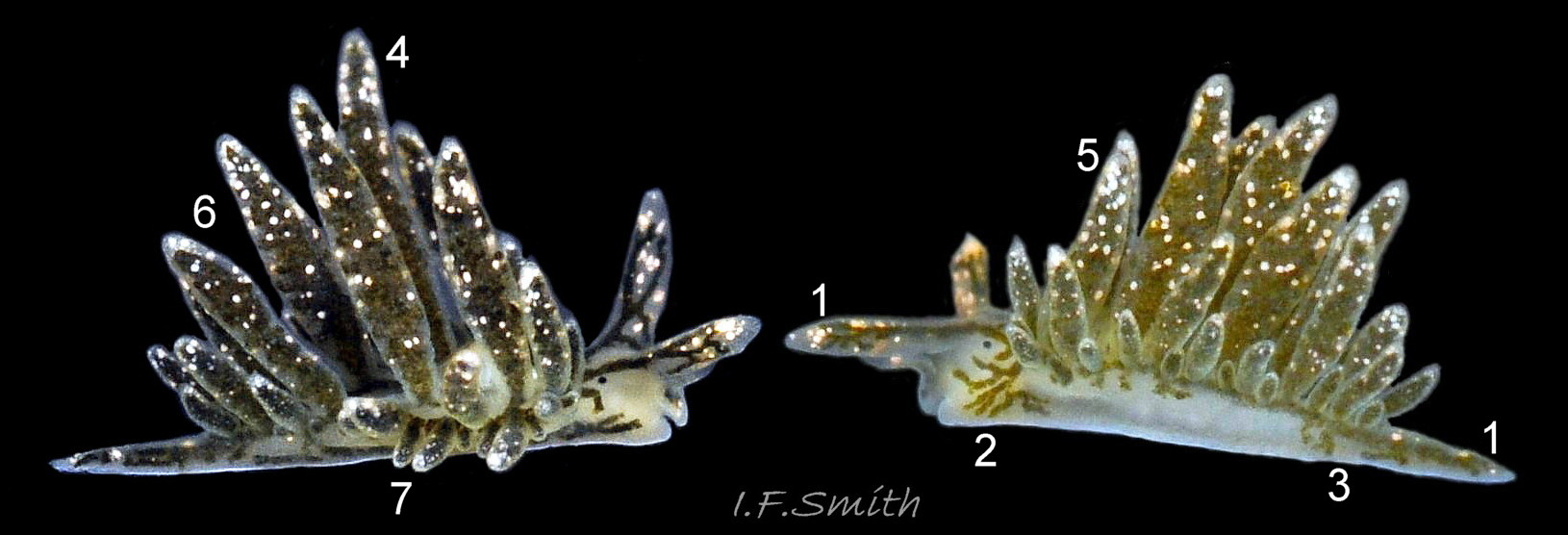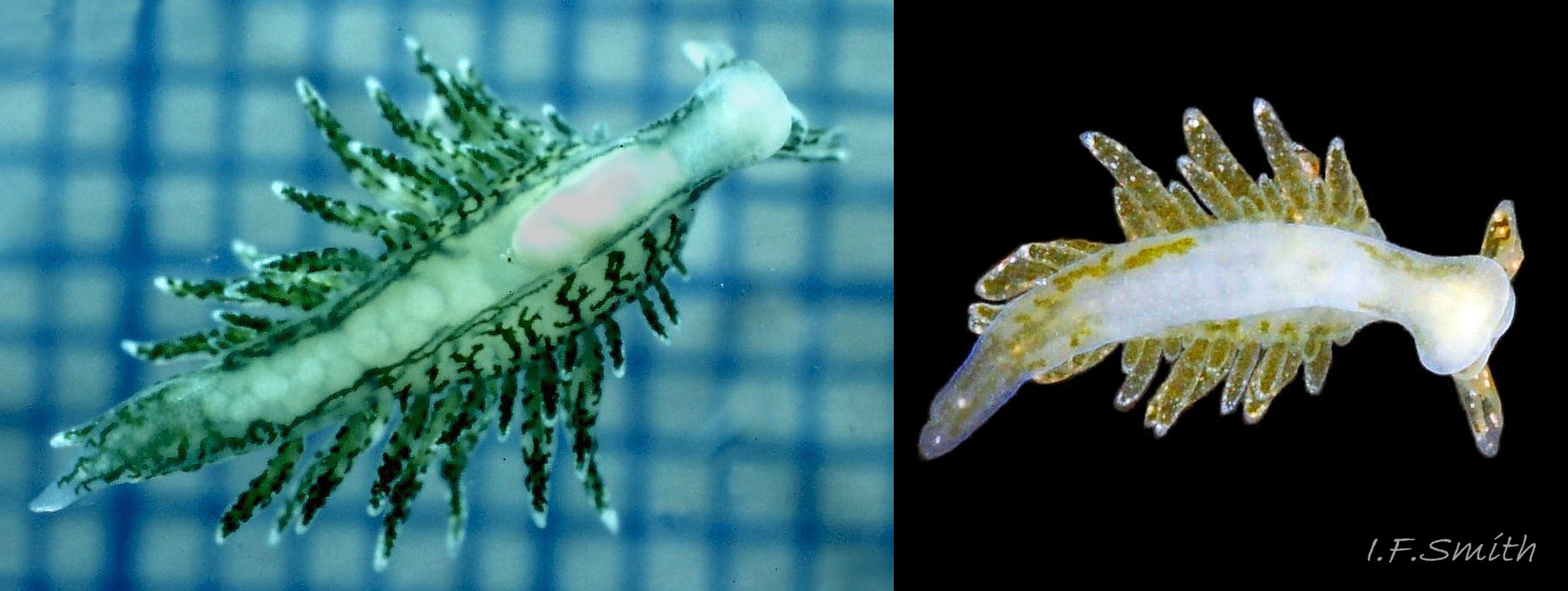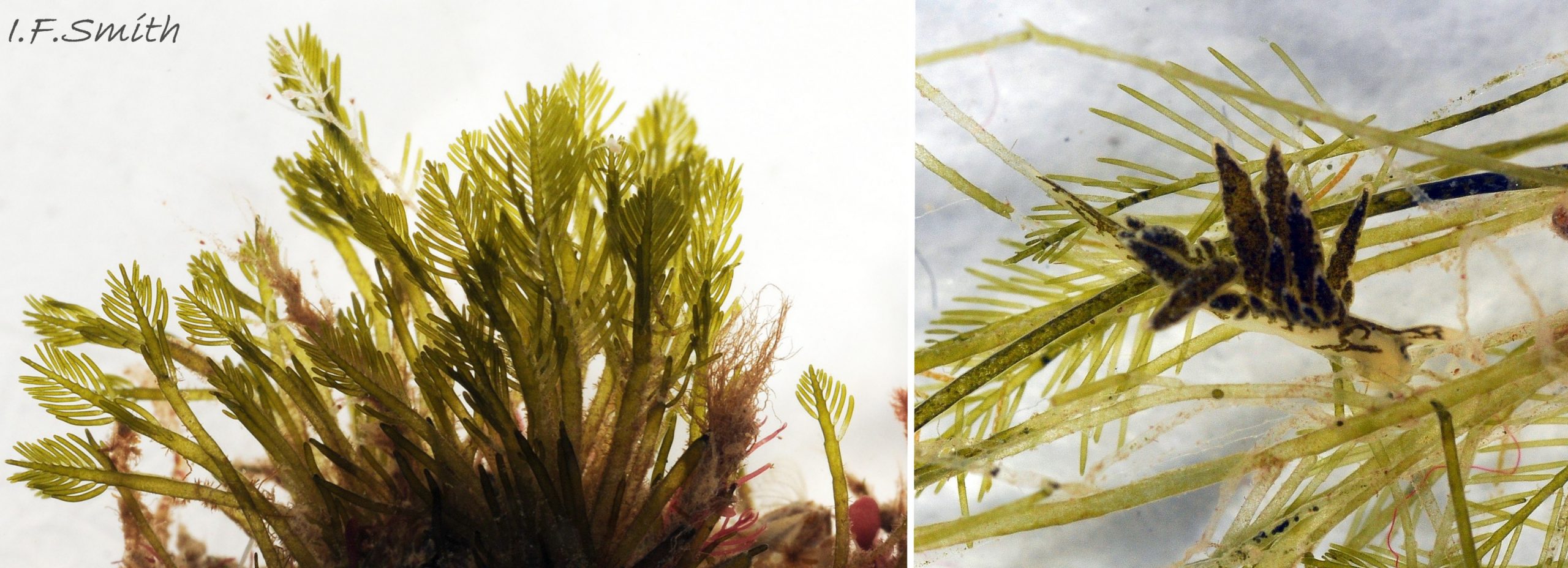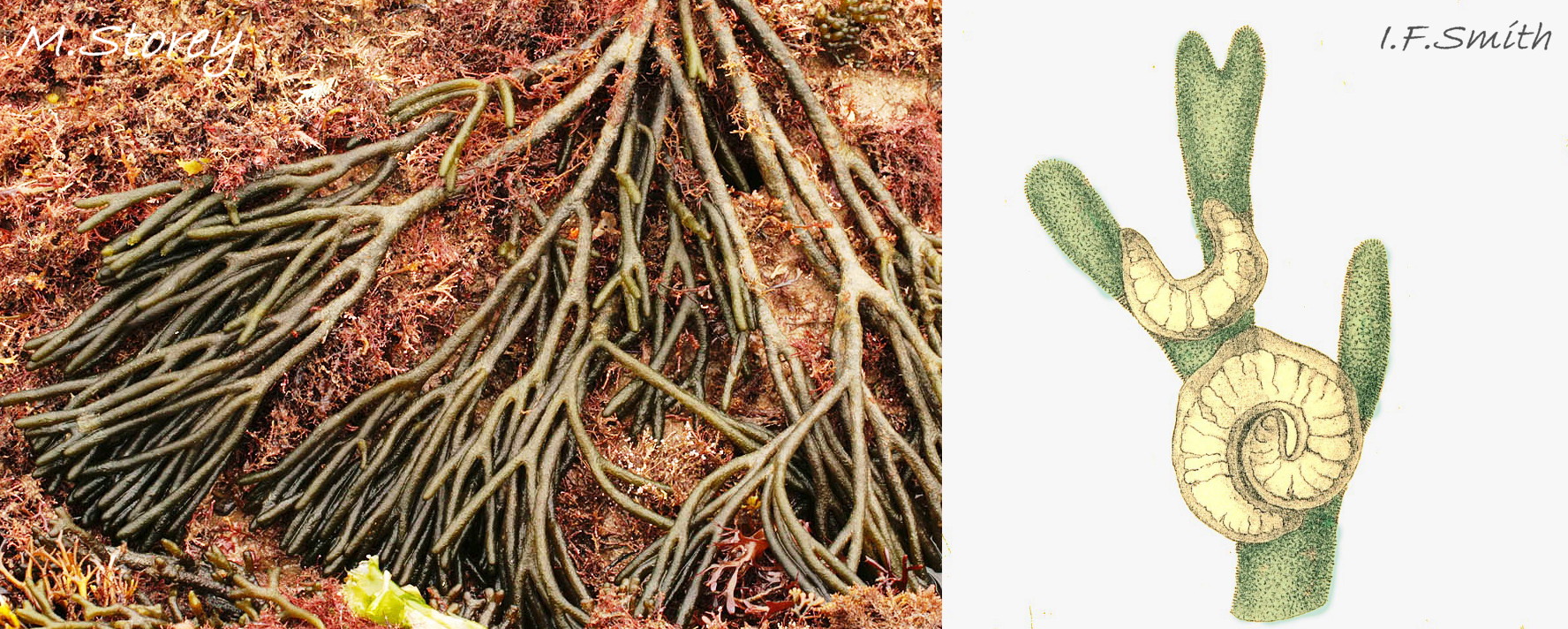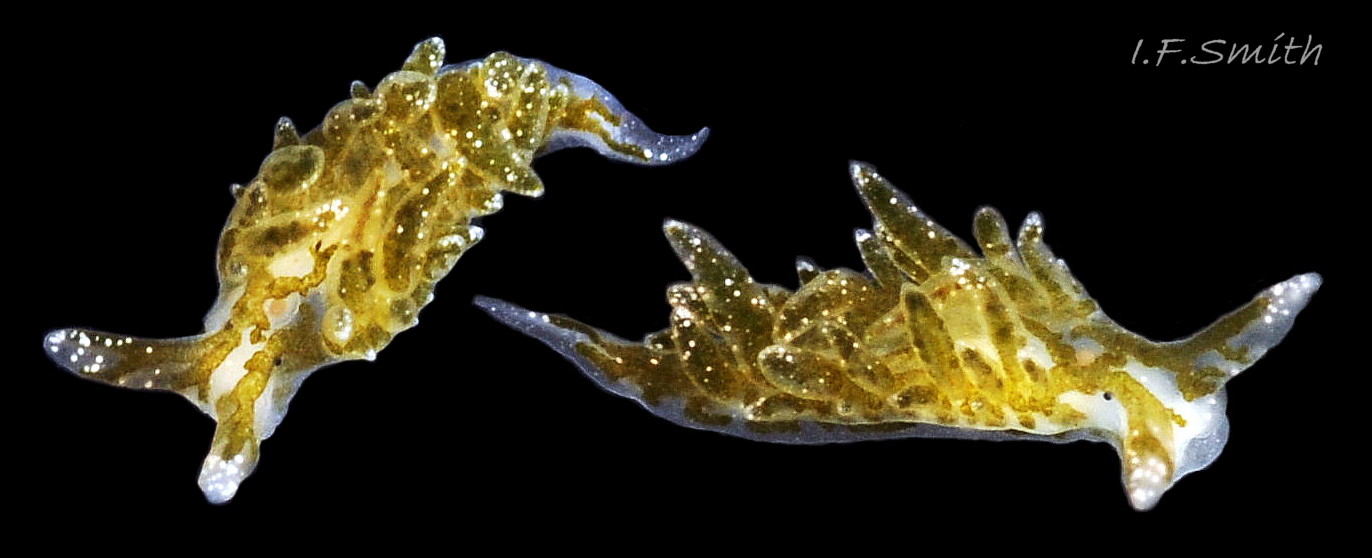Click image to enlarge with full caption. Main text below slider.
Placida dendritica (Alder & Hancock, 1843)
PDF available at www.researchgate.net/publication/351412587_Placida_dendri…
Current taxonomy; World Register of Marine Species www.marinespecies.org/aphia.php?p=taxdetails&id=141565
Synonyms:Calliopaea dendritica Alder & Hancock, 1843; Hermaea dendritica (Alder & Hancock, 1843).
GLOSSARY below.
Preface
Because they bear cerata on their backs, species in the genera Placida and Hermaea in the superorder Sacoglossa were classed as Eolididae in the order Nudibranchia by Alder and Hancock (1844 -1855) and are still initially thought to be nudibranchs by many observers. DNA sequencing has shown they are more closely related to land slugs than to nudibranchs. Unlike aeolid nudibranchs, they feed on algae and have no cnidosacs at the tips of their cerata for storage of cnidocytes (‘stings’), which aeolids sequester from their prey.
Description
The body grows up to 11 mm long ( 10 Placida dendritica). It is translucent white or greenish white with a distinctly visible, internal, green to olive-brown, dendritic, digestive gland which extends into the rhinophores and, as diverticula, into the cerata ( 01 Placida dendritica. ). The pericardium is a swelling behind the head with a faintly pinkish anus at its anterior ( 02 Placida dendritica ). White spheroid ovotestes are sometimes visible in the body (figs. 3 03 Placida dendritica & 6 06 Placida dendritica ).
The cerata are arranged on adults in up to nine groups of two to four each; the larger ones in each group are positioned more dorsally than the small ones (figs. 3 03 Placida dendritica & 4 04 Placida dendritica ). The cerata often conceal much of the body. They are transparent, showing the green diverticulum extending to the apex with no cnidosac ( 02 Placida dendritica ) though this is often obscured by the many white pigment spots on the surface of the cerata ( 04 Placida dendritica ). The colour of the digestive gland varies with diet and fades if a specimen has not fed recently. The rhinophores are smooth, translucent white or greenish white, enrolled tubes, slit ventrally when held horizontally ( 05 Placida dendritica ). Spots of white surface pigment on them are most concentrated distally. The head is white with green dendritic lines and has an eye laterally at the base of each rhinophore (figs. 4 04 Placida dendritica & 5 05 Placida dendritica ). There are no oral tentacles.
The slender foot has a translucent white sole which may reveal the spheroid ovotestes (fig 6 06 Placida dendritica ). The anterior of the foot is smoothly rounded and often expanded with no propodial tentacles. The dorsal surface of the foot has some green dendritic lines ( 04 Placida dendritica ). The metapodium often extends far beyond the cerata. Then, the total length of the animal is about eight times the width of the foot.
Key identification features
P. dendritica sensu stricto.
1) Found in Europe on green Bryopsis ( 08 Placida dendritica ) and Codium species ( 09 Placida dendritica ). Perhaps also on Derbesia species.
2) Body, up to 11 mm long, translucent whitish with dendritic green markings.
3) Rhinophore enrolled, with green markings.
Similar species
Hermaea bifida (Montagu, 1816), to 20 mm long ( 07 Placida dendritica), H. paucicirra Pruvot-Fol, 1953, to 6 mm and H. cantabra Caballer & Ortea, 2015, to 9 mm.
1) Found on finely branching red algae in order Ceramiales, including red epiphytes growing on green Codium.
2) Body translucent whitish with a reddish digestive gland forming a longitudinal band on each side connecting the bases of the cerata and extending into the cerata to their apices. Varying amounts of red elsewhere on the body; sometimes absent on and in unfed specimens which may be mistaken for P. dendritica ( 07 Placida dendritica ).
3) Enrolled rhinophores have with variable amounts of red pigment.
Habits and ecology
P. dendritica lives near ELWS and in the shallow sublittoral where there is enough light for its food algae Bryopsis ( 08 Placida dendritica ) and Codium species ( 09 Placida dendritica ). It may also feed on Derbesia spp. (C.D. Trowbridge 2021, pers. comm., 6 May). The entire thallus of these siphonaceous algae is a single cell which P. dendritica pierces with its leading radular tooth and from which it suctorially ingests the cytoplasm, ‘cell sap’, containing chloroplasts. The thallus becomes paler after removal of the cytoplasm, while the digestive gland and its diverticula in the cerata of the slug may darken with the ingested cytoplasm ( 08 Placida dendritica). Affected algae become pale and often fragment.
In a study in Oregon, USA, P. dendritica sensu lato on Codium spp. were generally smaller than those on Bryopsis corticulans, and, when similar sized individuals were compared, those on Codium had more numerous and shorter cerata, wider bodies and smaller, more numerous radular teeth than those on Bryopsis. Diet changes induced morphological changes in the P. dendritica s.l. (Trowbridge, 1997), and similar results were seen in New Zealand specimens (C.D. Trowbridge 2021, unpub.data, pers. comm., 6 May).
P. dendritica is a simultaneous hermaphrodite. Spawn, in a coil of about one and a half turns ( 09 Placida dendritica ) with up to 850 ova, is deposited in Britain in May-June on the food algae. Shelled veligers live in the plankton for several weeks before metamorphosing into adults.
Distribution and status
P. dendritica sensu stricto lives from Norway to the Mediterranean. NE and NW Pacific specimens may be cryptic species in a large sensu lato species complex (C.D. Trowbridge 2021, pers. comm., 6 May); GBIF map www.gbif.org/species/5192108 . There are also uncertain records from Australasia and South Africa. Before Bleakney (1989), many of the geographically distinct taxa were considered separate species, and more recent molecular work by Walsh and Trowbridge (2001 and unpubl. data) indicates that the synonymy may be unwarranted. There are scattered Irish and British records of P. dendritica; the species is probably under recorded as it is small and cryptic on its food algae. There are no records from the north-east Irish Sea or North Sea. UK distribution map NBN species.nbnatlas.org/species/NBNSYS0000177247
Acknowledgements
I am most grateful to Dr Cynthia D. Trowbridge for her help and advice with the text, but any errors or omissions are my (IFS) responsibility. I thank Helgi Winther Olsen and Malcolm Storey for use of their images and Paul Brazier for a sublittoral weed sample containing specimens.
References and links
Alder, J. & Hancock, A. 1845-1855. A monograph of the British nudibranchiate mollusca. London, Ray Society. www.biodiversitylibrary.org/item/131598#page/467/mode/1up
Bleakney, J.S. 1989. Morphological variation in the radula of Placida dendritica (Alder & Hancock, 1843) (Opisthobranchia: Ascoglossa/Sacoglossa) from Atlantic and Pacific populations. Veliger 32: 171-181. www.biodiversitylibrary.org/page/43054039#page/187/mode/1up
Thompson, T.E. 1976. Biology of opisthobranch molluscs 1. London, Ray Society.
Trowbridge, C.D. 1997. Dietary induction of opisthobranch morphology: Placida dendritica (Alder & Hancock, 1843) on different green algal hosts. J.moll.Stud. 63:, 29-38
www.researchgate.net/publication/249276587_Dietary_induct…
Trowbridge, C. D., Hirano, Y. J. and Hirano, Y. M. 2010. Sacoglossan opisthobranchs on northwestern Pacific shores: Stiliger berghi Baba, 1937, and Elysia sp. on filamentous red algae. Veliger 51: 43-62. www.researchgate.net/publication/235703273_Sacoglossan_Op…
Trowbridge, C. D. and Todd, C.D. 2001. Host-plant change in marine specialist herbivores: ascoglossan sea slugs on introduced macroalgae. Ecological Monographs 71 (2): 219-243.
www.researchgate.net/publication/250075515_Host-Plant_Cha…
Walsh, E.J. and Trowbridge, C.D. 2001. Genetic variation in oligophagous herbivores (Sacoglossa: Opisthobranchia) on native and introduced hosts. Abstract p. 384. World Congress of Malacology 2001. Vienna, Austria.
Current taxonomy; World Register of Marine Species www.marinespecies.org/aphia.php?p=taxdetails&id=141565
GLOSSARY
cerata = (sing. ceras) lobes on dorsum of aeolids and some other seaslugs.
chloroplast = organelle in the cytoplasm of a plant or algal cell which contains chlorophyll that photosynthesises to capture and store the energy from sunlight.
cnidocytes = explosive stinging cells of hydroids, jellyfish, sea anemones etc.
cnidosac = storage capsule at tips of cerata of Aeolidiidae, but not Sacoglossa, for ingested unexploded cnidocytes (‘stings’).
cytoplasm = gelatinous liquid that fills the inside of a cell; ‘cell sap’.
dendritic = branching like boughs, branches and twigs of a tree.
distal = away from centre of body or from point of attachment.
diverticulum = a side sac protruding from a hollow or fluid-filled structure in the body.
ELWS = extreme low water spring tide (usually near equinoxes).
metapodium = hind part of the foot.
ovotestis = hermaphrodite organ serving as both ovary and testis.
pericardium = membranous sac containing heart and start of aorta.
propodial = at the front of the foot.
rhinophore = chemo-receptor tentacle; nudibranchs, and some sacoglossans such as Placida and Hermaea, have a pair on the head.
suctorial = (adj. of feeding method) by sucking.
thallus = (pl. thalli) algal body.
veliger = shelled larva of marine gastropod or bivalve mollusc which moves by action of cilia on a velum (bilobed flap).

